Tag: Cumberland County
Volunteers and biologists add the next oyster reef to Dyers Cove
Team works through threat of downpour to strengthen Delaware Bay’s resiliency and ecology
By Emily Hofmann, Project Coordinator
Although the weather was on the brink of being rainy and bleak, that did not stop a team of dedicated biologists and volunteers from building an oyster reef on the Delaware Bayshore this past Saturday. Committed volunteers and young people braved the weather to work alongside American Littoral Society and Conserve Wildlife Foundation to build a near-shore oyster reef at Dyers Cove, at the end of Dyers Creek Road in Newport, Cumberland County, New Jersey.
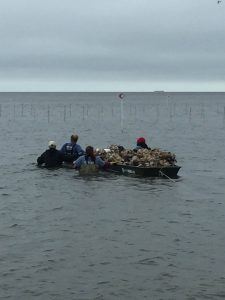
This reef – like the one at South Reeds Beach – was built to protect restoration work done after Hurricane Sandy and provide habitat. Constructed to prevent sand loss from wind-driven waves and create calmer water for spawning horseshoe crabs, this is the third of five such reefs that have been built by the Littoral Society and CWF. The conservation organizations will continue to monitor whether the reef breakwaters help reduce beach erosion and create calmer water for spawning horseshoe crabs.
Due to the heavy rain over the course of the week, the conditions were not ideal. Low-tide never went below waist deep, so it was hard to construct the reef accordingly. But that did not stop the team!
“Every oyster reef we’ve built so far on the Delaware Bay incorporated a different restoration strategy. We have had to adapt new strategies with what has worked best in the past and with what will realistically work based on site conditions. By blending the successes from the previous reefs with innovative approaches, we have been able to construct three reefs to date,” said Capt. Al Modjeski, Habitat Restoration Program Director for the American Littoral Society.
The bayshore beaches need restoration and improved resiliency so that horseshoe crabs have proper breeding grounds. Crab eggs feed migratory shorebirds, like the Red Knot, which stops in New Jersey each spring on its long journey from South America to the Arctic Circle. The Red Knot and other shorebirds help bring $11 million in tourist dollars to New Jersey’s Delaware Bayshore region each year.
“New Jersey’s Delaware Bayshore hosts an annual wildlife spectacle of global significance – the time-honored migration of Red Knots to reach the eggs of these ancient horseshoe crabs,” said David Wheeler, Conserve Wildlife Foundation of New Jersey Executive Director. “Volunteer projects like this help connect the people of New Jersey with these endangered shorebirds and the largest population of horseshoe crabs in the world.”
“Originally, this event was a bare-bones volunteer effort of placing shell bags off the Dyers Cove eastern beach,” said Capt. Al. “But thanks to a donation from Betancourt, Van Hemmen, Greco & Kenyon, we will have a ‘shell-a-bration’ that celebrates the ecology and community of the Delaware Bayshore.”
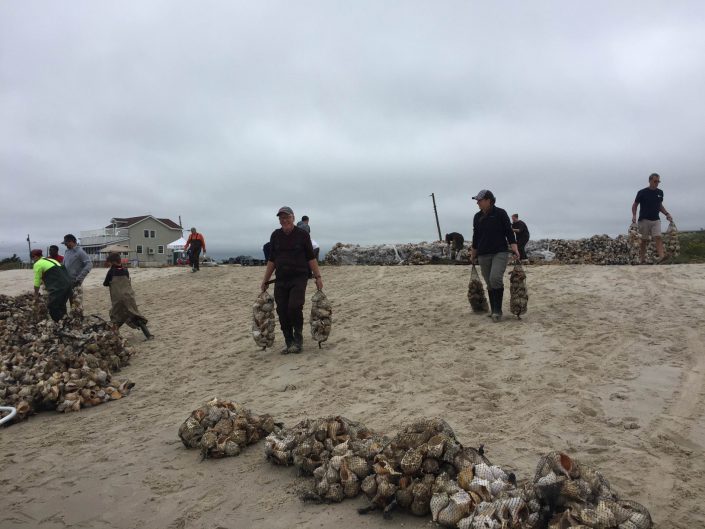
In 2015, over 130 volunteers and veterans built an oyster reef at South Reeds Beach in the first annual Shell-a-Bration. That same year, Veterans Day on the Bay dedicated the reef to all veterans and highlighted veteran involvement in the effort to restore New Jersey’s Delaware Bayshore. The second annual Shell-a-Bration, held in April 2016, saw a handful of dedicated volunteers brave a blizzard to build a reef at Moore’s Beach. The third annual Shell-Bration will be held this coming Spring 2017.
“There are many strategies to defend our Delaware Bayshore, but one of the best and most productive are these oyster reefs,” stated Dr. Larry Niles, a biologist with the American Littoral Society and Conserve Wildlife Foundation of New Jersey. “They not only replicate a lost but important habitat on Delaware Bay – reefs once covered much of the bayshore – but they provide just enough protection to make a difference in how long our beaches persist against the unrelenting forces of nature. In a way, we are fighting nature with nature.”

The projects are being funded by National Fish and Wildlife Foundation (NFWF) through their Hurricane Sandy Coastal Resiliency Grants Program, and are being developed in partnership with U.S. Fish and Wildlife Service and New Jersey Division of Fish and Wildlife.
Emily Hofmann is a project coordinator for Conserve Wildlife Foundation
LEARN MORE
- Learn more about our work to restore Delaware Bay at RestoreNJBayshore.org
- Conserve Wildlife Foundation’s Delaware Bay Restoration Work
- Previous oyster reef building events along the Delaware Bay
- What goes on along the Delaware Bay
Update On “Jersey Girl:” A Jersey Eagle Nesting In Pennsylvania
‘Jersey Girl’ and Her Mate Rebuild Nest for the 2016 Nesting Season
by Larissa Smith, wildlife biologist

We continue to follow the story of “Jersey Girl” B-64. She was banded in Hopewell, Cumberland County, New Jersey in 2004 and this is the fifth season her and her mate have nested in Montgomery County, Pennsylvania. In 2015 after successfully raising three chicks, their nest collapsed due to rain and wind at the end of June, but luckily the three chicks had already fledged.
Nest observer Lind Oughton reported, “Well our great ‘Jersey Girl’ and mate have done it again. They built a brand new nest in the same tree but about 15 feet lower that the first nest. It is much more secure where it is now.” She reported incubation on February 12th and hatching around March 18th. On April 1st, she saw one chick in the nest. We will continue to follow “Jersey Girl’s” story and keep you updated.

Learn More:
- Successful Nesting Season for “Jersey Girl”
- New Jersey Banded Eagle “Jersey Girl” Makes the News
- Conserve Wildlife Foundation’s Bald Eagle Project
Larissa Smith is a wildlife biologist for Conserve Wildlife Foundation of New Jersey.
Photo from the field
Installing a nestbox for peregrine falcons on a water tower
by Ben Wurst, Habitat Program Manager
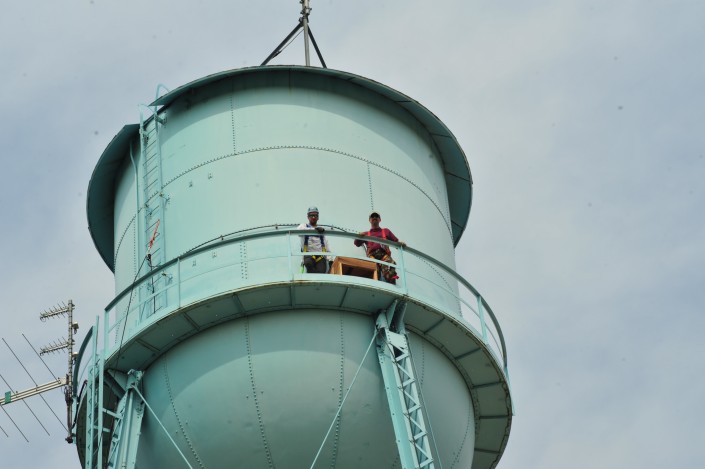
The installation of a custom made nestbox on a water tower is no easy task. Just climbing this tower is a scary feat. First off the tower is over 70 years old and has little safety features on it. You rely on your own climbing gear and strength to safely climb this tower. After several delays, we successfully got the nestbox up on the water tower where we hope to get peregrines from another nest site to nest.
This site was chosen because it is suitable habitat for peregrines to nest and there are adequate prey resources in the area (pigeons, starlings, and doves). Peregrine nest sites were once along the D. Bayshore in this area, but a recent study conducted in coastal Virginia found that peregrines there were negatively influencing the behavior of migratory shorebirds. This spring the decision was made to remove a nestbox that was located along the Bay to help protect species like the endangered red knot while they feed on horseshoe crab eggs.
I constructed the nestbox from salvaged wood from the Forest Resource Education Center’s sawmill. It’s a mixture of white cedar, western red cedar, and scrap plywood (from construction of bat houses). Reusing salvaged wood is something I am really passionate about. I make all sorts of things from it including picture frames that I sell, furniture, and osprey platforms.
All About Eagles…
Bald Eagle Project meeting and Cumberland County Eagle Festival
by Larissa Smith, Biologist & Volunteer Manager
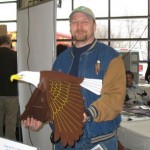
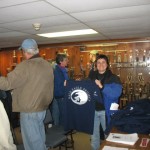
On Saturday February 5th thirty eagle project volunteers met to discuss the 2011 eagle season. The meeting took place during the Cumberland County Eagle Festival which is held the first Saturday in February. It was a rainy day but that didn’t keep the volunteers away.
During the festival there were talks, walks, vendors and educational displays. Eagle Project volunteer Kevin Buynie made and donated two eagle shaped bird houses to CWF. We raffled one off at the festival and it was a big hit!
People stopped by the CWF table and reported eagle sightings and a few possible new eagle nests. It is always nice to see how interested people are in eagles, raptors and wildlife in general.
Thank you to everyone who came out to visit us and support our work to monitor and conserve eagles in New Jersey!